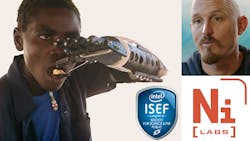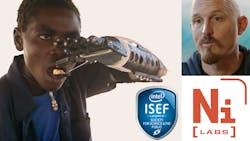This week I am in Los Angeles at the Intel International Science and Engineering Fair (ISEF) that is run by The Society For Science & The Public. Right now the students are being judged so I have a chance to write up some of the events that have happened thus far. The one with the most impact was the presentation given by Mick Ebling, CEO and found of Not Impossible Labs (Fig. 1). Mick’s presentation was ebullient, impassioned, insightful and inspiring.
Related Articles
- Science Fair Rules
- Intel International Science and Engineering Fair Invades Pittsburgh
- Intel International Science and Engineering Fair
- Mercer Science and Engineering Fair
Not Impossible Labs was started to turn the impossible into the possible. Mick talked about two of the projects they have done including Project Daniel and Eyewriter.
Project Daniel uses 3D printers to create prosthetic limbs for children in war torn Sudan. Fourteen year old Daniel was the first recipient. The project was not just to deliver a pair of prosthetic arms but to bring a lab and training facility that could be run by local people to help more people because Daniel’s plight is not unique. Too many children have missing limbs because of the conflict.
Prosthetic limbs normally cost thousands of dollars. Project Daniel is turning out limbs for a hundred dollars making it practical in Sudan’s Nuba Mountains. Dr. Tom Catena helped the team work in the extreme conditions using portable computers and 3D printers. Local traninees have successfully created additional prostheses for others although tragically the site has been bombed.
Project Eyewriter actually came first. It started with Los Angeles artist Tempt One who was fully paralyzed due to ALS (Lou Gehrig’s disease). ALS means he cannot move or breathe unassisted and communication and art were outside the realm of possibility.
Initially Eyewriter was designed as a way to provide communication that was very hard in the past. Essentially another person would hold a card up with the alphabet and move their finger across until the person with ALS blinked indicating the desired letter. Word and sentence construction was slow and tedious.
Eyewriter is a low cost eye tracking systems (Fig. 2). Selection is done by blinking although brain activity is being used next because even blinking can be hard for an ALS patient especially as the disease progresses.
If you want to build your own Eyewriter then you need these items.
- 1x cheap sunglasses
- 1x webcam
- 1x floppy disc
- 1x wire hanger
- 1x wire cutters
- 1x electrical tape
- 2x zipties
- 1x super glue
- 1x set of small screwdrivers
- 1x regular screw drivers
- 1x measuring tape or ruler
The Not Impossible Labs and Eyewriter website has more details and videos about how this has been done. The long-term goal for the communities is to create a professional and social network that includes software developers, hardware hackers, urban projection artists and ALS patients from around the world to facilitate open source research to creatively connect and make eye art.
Project Daniel and Eyewriter are impressive engineering projects but Not Impossible Labs is more impressive in its goals. Their motto is: Technology for the sake of humanity.
They utilize crowd sourcing and crowd funding to address previously insurmountable healthcare issues. They look to deliver low cost, open source, DIY (do it yourself) platforms that make it practical for use by a wide range of people.
Mick could not have had a better audience in the students competing at ISEF. Many of these students are doing similar thing in different areas.
One thing Not Impossible Labs also shows is that a breadth of support is needed even in projects like these. Marketing and public relations help bring about collaboration with companies like Intel to expand the solutions from an individual to the public. This may help turn some of these science fair projects into something that can help hundreds of people.
Mick’s enthusiasm is contagious. So is that of the students at ISEF. It will be interesting to see how they build upon each other and what kinds of efforts will result from new collaborations that start here.
About the Author
William Wong Blog
Senior Content Director
Bill's latest articles are listed on this author page, William G. Wong.
Bill Wong covers Digital, Embedded, Systems and Software topics at Electronic Design. He writes a number of columns, including Lab Bench and alt.embedded, plus Bill's Workbench hands-on column. Bill is a Georgia Tech alumni with a B.S in Electrical Engineering and a master's degree in computer science for Rutgers, The State University of New Jersey.
He has written a dozen books and was the first Director of PC Labs at PC Magazine. He has worked in the computer and publication industry for almost 40 years and has been with Electronic Design since 2000. He helps run the Mercer Science and Engineering Fair in Mercer County, NJ.
- Check out more articles by Bill Wong on Electronic Design
- Bill Wong on Facebook
- @AltEmbedded on Twitter


